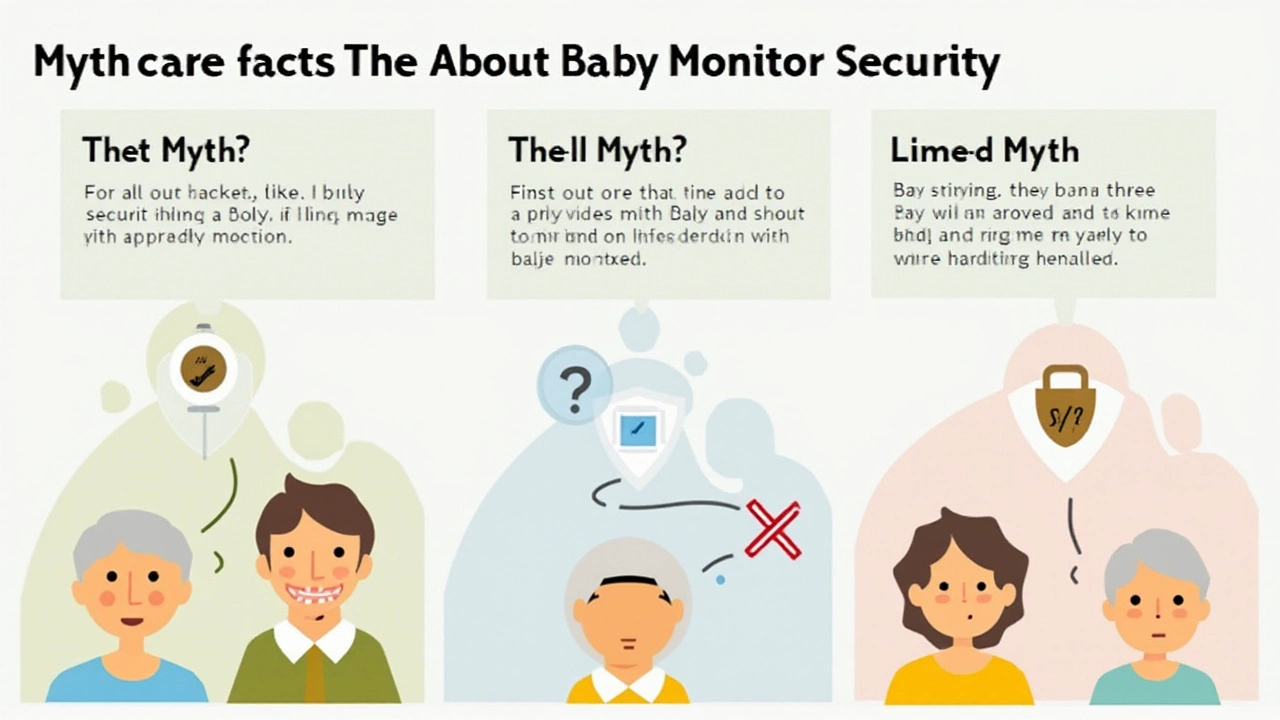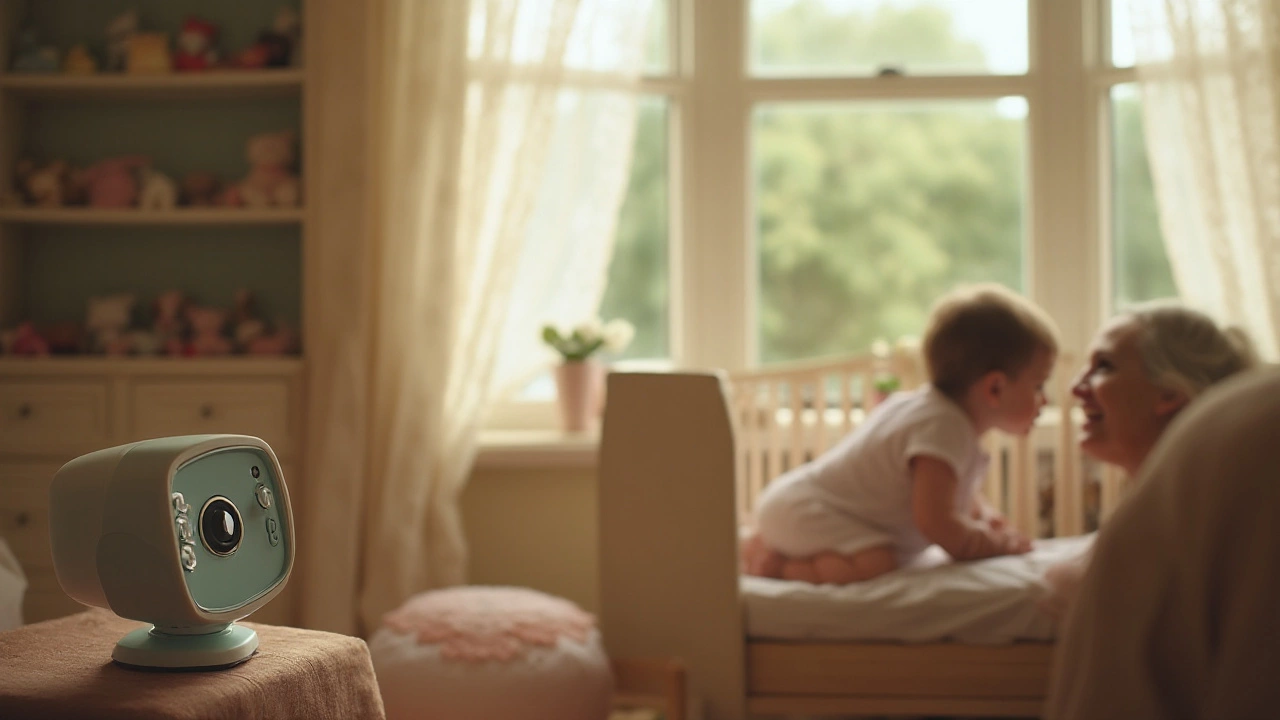In a world that's swiftly shifting to smart everything, baby monitors stand as essential tools for modern parenting. But as technology evolves, so does the concern for security, particularly with devices that watch and listen. Non-WiFi baby monitors, while appearing relatively simple, aren't free from risks, which makes this topic worth exploring.
The idea that a monitor isn't susceptible to hacking just because it doesn't rely on WiFi is a widespread belief. But is there any truth to this notion? Are there hidden vulnerabilities that parents should be aware of, even in seemingly low-tech devices?
This article aims to shine a light on this subject by dissecting myths, laying out possible threats, and offering practical advice for parents aiming to keep their family secure. The guide will help you navigate the choices in baby monitoring, so that precious time spent watching over your little one remains safe and sound.
- Understanding Non-WiFi Baby Monitors
- How Hacking Works: The Basics
- Security Risks for Non-WiFi Baby Monitors
- Myth or Reality: Can They Really Be Hacked?
- Practical Tips to Enhance Monitor Security
- Choosing the Right Baby Monitor for Your Family
Understanding Non-WiFi Baby Monitors
Non-WiFi baby monitors might seem like relics of the past in a time where everything is connected to the internet, but these devices still hold a special place for many parents. At their core, they operate on analog or digital radio frequencies to transmit audio and video signals. This means they don't need the internet to function, which is a big draw for anyone concerned about online security risks. These monitors typically use either the 49 MHz or 900 MHz frequency bands, which were once common in early cordless phones.
Many believe that because non-WiFi monitors are offline, they're immune to the hacking challenges faced by their internet-dependent counterparts. While it's true that they don't fall prey to the typical cybersecurity threats, they are not completely without risks. Much like analog radio, they can be intercepted by anyone with a similar receiver tuned into the same frequency, which is why manufacturers use protocols to enhance privacy. For instance, digital enhanced cordless telecommunications (DECT) technology provides a layer of encryption to deter eavesdropping without needing a connection to the internet.
A wide variety of non-WiFi baby monitors are available today, designed to meet diverse needs. From basic sound-only models to feature-rich options with video and night vision, the choices are vast. Parents who are concerned about hacking often prefer these options for their perceived security. However, this doesn't mean they're completely foolproof. It's always crucial to ensure that any baby monitor is positioned securely and used within its ideal range to prevent unintended interception.
According to a study by BabyGearLab, "While non-WiFi monitors are generally more protected against remote hacking, they still face interception risks, which makes choosing the right device and knowing its limitations crucial for any parent."
The differences between digital and analog non-WiFi monitors also play a role in security. Digital systems often employ some form of signal hopping or encryption to minimize interference and the chances of unwanted listeners tuning in. Meanwhile, analog monitors, known for a clearer and crisper transmission, can face interference from other devices on the same frequency, which is something to consider depending on where you live.
In selecting a non-WiFi baby monitor, it's vital to weigh the benefits against potential drawbacks. While they do not necessitate complex setup or updates like their smart counterparts, knowing their limitations and how they fit within your home's unique environment makes all the difference. In a landscape where parents are faced with endless choices, knowledge is indeed the best tool to ensure peace of mind and the safety of your little one.
How Hacking Works: The Basics
To understand how even a non-WiFi baby monitor might be compromised, it's important to grasp the basics of hacking. Hacking, quite simply, is unauthorized access to a system. Hackers often exploit weaknesses in the design or build of electronic devices to gain access. Though WiFi networks are commonly targeted due to their connectivity convenience, there are other ways to breach devices that don't use internet connections.
Non-WiFi monitors usually operate using analog radio frequencies or digital proprietary signals for sound and video transmission. Hackers might use radio scanners, which can pick up analog signals transmitted by a baby monitor. Though this requires the hacker to be in relatively close proximity to your home, it can still be a significant concern. Digital monitors often feature encrypted signals; however, sophisticated hackers might intercept these if they manage to penetrate the encryption method.
It's important to note that the likelihood of these hacks happening, especially with the advancements in encryption for digital monitors, remains relatively low. Yet, understanding how these invasions occur might make parents more vigilant. An important quote from cybersecurity expert Bruce Schneier suggests that "Security is a process, not a product." This highlights the need for continuous awareness and security practices.
Interestingly, some models of non-WiFi baby monitors, like those utilizing FHSS (Frequency Hopping Spread Spectrum), take security measures a step further by constantly changing frequencies. This technology makes it difficult for anyone to intercept a specific channel. However, as technology advances, so do hacking techniques, making it a perpetual game of cat and mouse between cyber defenders and attackers.
Being aware of these vulnerabilities doesn't mean you should ditch your non-WiFi baby monitor entirely. Instead, it provides an opportunity to learn and adjust your practices. It's a call for parents to evaluate device features, keep abreast of security updates, and avoid complacency. Devices, like all tech gadgets, require care and attention to secure against possible threats.
| Frequency | Security Risk Level |
|---|---|
| Analog | High |
| Digital | Moderate to Low (if encrypted) |
| FHSS | Very Low |
This table shows how different transmission methods influence security levels in terms of hacking risks. Giving thought to which category your baby monitor falls into can be a strategic step in safeguarding your home environment.

Security Risks for Non-WiFi Baby Monitors
When it comes to baby monitors, security might not be the first thing that comes to mind for many parents. The primary concern is often keeping an ear or eye on their sleeping infant. However, non-WiFi baby monitors, typically considered as safer alternatives due to their lack of internet connectivity, can still present certain security risks. These devices operate using radio frequency (RF) signals to transmit audio and sometimes video from the nursery monitor to the parent unit. While the range might be limited compared to WiFi-enabled versions, there is a risk that the signals could be intercepted by someone with the right equipment, particularly if they are within close proximity.
The concept of radio frequency eavesdropping is more than just a theoretical possibility—it's real and has been demonstrated. As these devices usually allow signals to travel unchecked, anyone with a suitable receiver, such as a modified baby monitor, could potentially listen in on your baby's room. Even though such occurrences are rare, they are not impossible. For instance, reports have emerged in various tech forums of neighbors inadvertently picking up each other's baby monitor signals, leading to privacy concerns. Non-WiFi baby monitors, while less targeted than their internet-connected counterparts, are not entirely free from intrusion threats.
Some might assume that because these monitors don't connect to the internet, they are entirely secure, but physical access to the signal's broadcast range and the lack of encryption make them vulnerable. This concern means that if someone wanted to, and knew exactly what they were doing, they could potentially listen to what's happening in the nursery. In addition, advancements in RF scanning devices mean that even the cheapest tech can sometimes intercept these baby monitor signals.
Security expert Bruce Schneier once said, "You can’t secure what you don’t know," highlighting the importance of understanding the devices we use daily, even those we consider low-risk like a baby monitor.
Interestingly, a few manufacturers have begun to address these concerns by introducing features such as dynamic frequency selection which changes frequency bands frequently to prevent eavesdropping. However, these models can sometimes be more expensive. It’s also worth noting that while these improvements help, they are not foolproof solutions and can still potentially be penetrated by someone with sophisticated equipment and knowledge.
Parental vigilance is key. It is advised to perform regular checks on the functioning of any baby monitor and to be wary of surprising behavior patterns, like unexplained static or interference, which could indicate that someone with a similar device is inadvertently—or deliberately—tuning into your monitor's signal. Being cautious about where you place the monitor can also help reduce these risks. It might be wise to position the baby monitor in such a way that it isn't broadcasting sensitive conversations that happen around the device.
Myth or Reality: Can They Really Be Hacked?
When it comes to the security of non-WiFi baby monitors, many parents breathe a sigh of relief, thinking that lack of internet connectivity shields them from hackers. The typical design for these monitors uses radio frequencies to transmit audio and video signals between the camera and the receiver. So, is this need for comfort justified?
Non-WiFi baby monitors operate like good old radios, which means their signals can potentially be intercepted. Imagine listening to someone else's favorite radio station by accident—that's akin to what could happen with these devices. This possibility arises because a lot of non-digital devices lack the encryption capabilities that modern tech relies on for security.
The level of risk might also depend on the frequency band that your device operates on. Most non-WiFi baby monitors operate on the 49 MHz, 900 MHz, or 2.4 GHz frequency bands. Interestingly, the 2.4 GHz frequency is also used by many common household devices, including microwaves and cordless phones. This overlap can sometimes create interference, but it also opens the door for interception by those with the know-how.
There is a debate on whether such hackers exist commonly or not, yet anecdotal stories have surfaced on forums and parenting groups expressing concerns. Some parents have claimed interference from other devices temporarily allowed them to listen in to monitors—a disconcerting experience. Regardless, these tend to be infrequent.
According to a tech security specialist featured in a parenting magazine, "The chance of interception is low, but it's not zero. Parents should be aware of the risks and operate their devices in a cautious manner."
If you're still worried about the possibility of being eavesdropped on your baby monitor, it's worth knowing that not all monitors are built the same. Investigating the potential vulnerabilities of your specific model can offer some peace of mind. Additionally, look for devices that offer a DECT system, which encrypts the transmission, making it harder for others to listen in.
While completely eliminating interception risk is nearly impossible, awareness and smart usage can diminish it significantly. It's crucial to stay informed on the technology that allies us in parenting, ensuring the safety of your loved ones in the most educated manner possible.

Practical Tips to Enhance Monitor Security
When it comes to ensuring the security of your non-WiFi baby monitor, it might seem as simple as plugging it in and hoping for the best. But the landscape of modern privacy concerns asks for more than just trust. Start by knowing what kind of technology your monitor uses. Most non-WiFi monitors employ radio frequencies to transmit audio or video signals, which can be vulnerable to interception. A wise tip is to check the packaging or documentation for details about encryption. Encryption acts as a protective shield, making your data less accessible to potential eavesdroppers.
Another straightforward yet often overlooked practice is to regularly update the monitor's firmware if the option is available. Manufacturers occasionally release updates that can patch potential vulnerabilities, much like how smartphones receive updates. This kind of maintenance ensures you're one step ahead of any security shortcomings. Additionally, you might want to position the unit's microphone and camera thoughtfully. Ensure they're angled to capture what really matters while minimizing accidental coverage of private areas of your home.
Speaking of discretion, consider adopting a 'less is best' policy. Keep sensitive discussions and private affairs away from the monitor's range whenever possible. This might sound old-school, but safeguarding your family's privacy often starts with small habits. For those who wish for an extra layer of cybersecurity, devices like Faraday cages, which block electromagnetic fields, can add another level of security. But they might not always be necessary if you've done your homework, like selecting a monitor with a reputable brand that prioritizes security in its design.
In some cases, a little anecdote can provide comfort or caution. As one tech writer once noted, “A baby monitor is not an inherent vulnerability, but like leaving the front door open, one should not assume it’s a closed loop.”
Moreover, keep in mind that everyday actions can impact the security of your monitor. Switch it off when not in use to reduce exposure time and lower risk. Also, consider resetting the monitor's channel occasionally. This randomizes the frequency, making any would-be eavesdropper's job a bit harder. Think of it as changing the locks on your home now and then.
Lastly, research is your best ally. Checking reviews and forums where other parents share their experiences with different models can uncover any undocumented problems or praised features. Always approach your decision armed with knowledge and support from a community of parents navigating the same concerns. Remember, maintaining the security of your baby monitor is less about paranoia and more about ensuring peace of mind for you and the safety of your child.
Choosing the Right Baby Monitor for Your Family
Finding the ideal baby monitor involves understanding your family’s unique needs. It starts with grasping how a baby monitor fits into your daily routine, ensuring it serves both practicality and peace of mind. With numerous options on the market, the task can seem overwhelming. Yet, some straightforward considerations can make selecting a suitable monitor far less daunting.
First, consider the environment where the monitor will operate. If your home has a lot of interference from other devices or thick walls, a digital monitor could offer a clearer signal compared to analog. Digital monitors encrypt data, adding an extra layer of security. On the other hand, if you have specific concerns about bandwidth usage or device compatibility, a non-WiFi baby monitor might be the best choice to avoid connectivity mishaps or unwanted overlaps with other smart devices.
Features to Consider
When choosing, reflect on the features that you will find most beneficial. Video capability is indispensable for watching your baby in real-time, but perhaps audio is enough for your household's needs. Consider models with high-definition, night vision, and remote panning if you want more detailed monitoring. For sound-only monitors, check for adjustable sensitivity settings to ensure you capture only the necessary sounds without static noise.
Range is a critical factor as well. Make sure the monitor covers the necessary distance, especially if you live in a larger home or plan to use it in various locations. Portability, battery life, and ease of charging are practical aspects that cannot be ignored. It’s crucial that the monitor can keep pace with your active lifestyle without constant power concerns.
"A parent's peace of mind can largely depend on choosing the right baby monitor, blending technology with the trust," says Jane Smith, a renowned child safety expert.
Cost vs. Value
The price range of baby monitors can vary dramatically, so it's essential to weigh cost against what you value most in a monitor. While budget models may offer basic features at an affordable rate, reviewing warranties and user reviews can provide insight into their reliability. On the opposite spectrum, premium models may boast advanced features like heart rate monitoring or connected apps. However, it's vital to ensure these extra features align with your genuine needs rather than getting swayed by luxury listing.
Lastly, always check customer reviews and seek recommendations from friends or family. Real-world usage can often reveal insights about the product's reliability and any potential issues that aren't immediately apparent through product descriptions.
